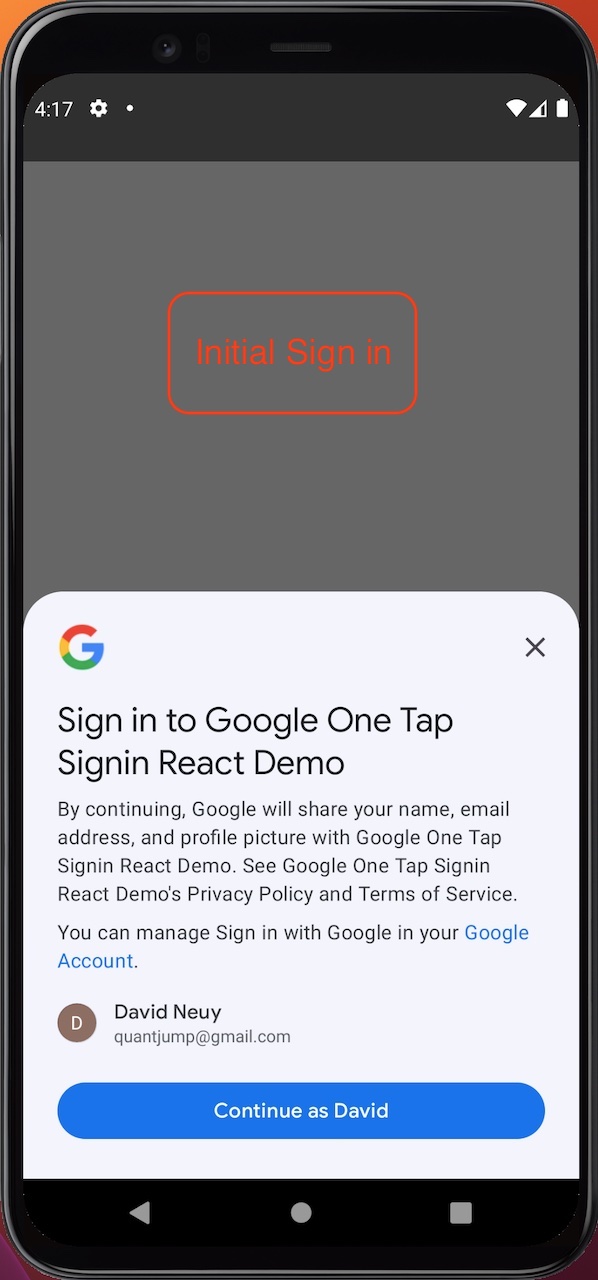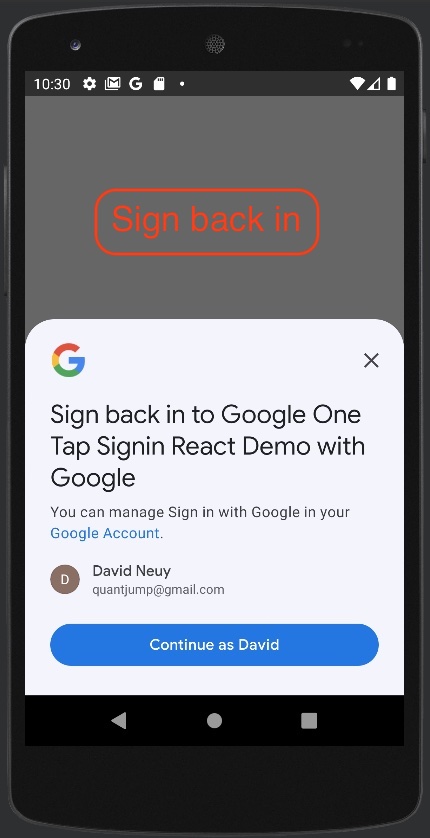Capacitor Native Google One Tap Signin plugin
Wraps the native android One Tap api for ionic capacitor apps. One Tap Sign In is part of Sign in with Google and offers features as automatic sign-in on return visits.
This library intends to provide the best google authentication experience for each platform.
After a successful authentication, the idToken is returned as base64 and as object.
The user is automatically signed-in, without a prompt after the first sign-in.
The android minSdkVersion is 24, however the one-tap library seems to require API version 29. For lower API versions GoogleSignIn is used.
Install and Configure
The major version of this plugin indicates the capacitor version that it is compatible with.
1. Install package
npm i --save capacitor-native-google-one-tap-signin2. Update capacitor dependencies
npx cap update3. Configure
Authentication is based on cryptographic keys, so you need to create a client ID for each platform in Google Cloud Console.
-
For the web platform, you need to create a client ID of type "Web application". When creating the client ID for development add two "Authorized JavaScript origins". One with URI "http://localhost:3000" and one with URI "http://localhost". "Authorized redirect URIs" is not needed. Copy the generated client ID and pass it in the
initializecall. Note that if you host the app not on localhost or on a different port, you will either need to add more origins or add another client ID.
If you get the error[GSI_LOGGER]: The given origin is not allowed for the given client ID.even though you have set the origin, you should check the headers that your server sets. Requests from the iFrame created by the google library must include the origin header. The browser will only set the header for requests from an iFrame if your server does not set theReferrer-Policyheader tosame-origin. Configure your server to not set the header. Additionally it may be needed that your server responds with aCross-Origin-Opener-Policyheader value ofsame-origin-allow-popups. -
For the android platform, you need to create a client ID of type "Android", as stated in One Tap Get started docu. You just need to create that client ID, you do not need to include it in any config. It is linked to your app via the package name and SHA-1 signing certificate fingerprint of your app. Note that usually the signing certificate for developments builds is different than for app store builds so you will need to create a client ID for development builds and one for app store builds.
-
For the ios platform, you need to create a client ID of type iOS in the Google Cloud Console. Add the client ID to the
{your-app}/ios/App/App/Info.plistfile with the keyGIDClientID(see the demo app for reference). When creating the client ID, you will see the "iOS URL scheme" value in the Google Cloud Console. Add this also to theInfo.plistfile.
Usage
import { GoogleOneTapAuth, SignInResult } from 'capacitor-native-google-one-tap-signin';
await GoogleOneTapAuth.initialize({ clientId: clientId });
// Example 1: Showing the button only if auto-sign-in or one-tap sign in fail.
const signInResult = await GoogleOneTapAuth.tryAutoOrOneTapSignIn()
.then(res => res.signInResultOptionPromise);
if (signInResult.isSuccess) {
console.log(signInResult);
} else {
const successResult = await GoogleOneTapAuth
.renderSignInButton('google-signin', {}, { text: 'continue_with' });
console.log(successResult);
}
// See the demo folder for an example application.import { GoogleOneTapAuth, SignInResult } from 'capacitor-native-google-one-tap-signin';
await GoogleOneTapAuth.initialize({ clientId: clientId });
// Example 2: Trigger auto-sign-in or one-tap sign and show the button in parallel.
const autoOrOneTapSuccessPromise = GoogleOneTapAuth.tryAutoOrOneTapSignIn()
.then(res => res.successPromise);
const renderButtonPromise = GoogleOneTapAuth
.renderSignInButton('google-signin', {}, { text: 'continue_with' });
const signInResultSuccess = await Promise.race([autoOrOneTapSuccessPromise, renderButtonPromise]);
console.log(signInResultSuccess);
// See the demo folder for an example application.Run the demo app
This repository contains a demo app in the demo/react folder. See the README there.
Notes about testing with an emulator
To test it using an emulator, you need to create an emulator with android play services and API version 24 or higher. See my stackoverflow answer. For older API levels like 24, you may need to update Chrome after creating the emulator because the plugin targets JavaScript es2017.
Supported platforms
Android, iOS, Web.
Detailed description of different use cases
See https://developers.google.com/identity/gsi/web/guides/features
Exposed api
See src/definitions.ts for a complete definition.
/**
* Performs common or one-time initializations.
* For the web platform, starts pre-loading the google one tap JavaScript library.
* initialize must be called before any other method.
* initialize remembers if it was called so it is safe to be called multiple times.
* Other methods wait till initialize is finished so you must not await initialize.
* @param options
*/
initialize(options: InitializeOptions): Promise<void>;
/**
* Tries to either auto-sign-in the user or sign-in the user with just one tap/click.
* If there is a single google account and that account has previously signed into the app,
* then that user is auto signed in. A short popover is displayed during sign-in.
* If there are multiple google accounts and more than one have previously signed into the
* app then a user selection screen is shown.
* If there is no active google session or if no user session has logged in previously in
* the app or if the user has opt out of One Tap, then the response will indicate that
* the auto sign-in did not succeed.
* See https://developers.google.com/identity/gsi/web/guides/features
* @returns A Promise object that contains 3 properties with promises. One resolves only
* when authentication succeeds, the second on error and the third on success or error.
*/
tryAutoOrOneTapSignIn()
: Promise<{
successPromise: Promise<SuccessSignInResult>;
noSuccess: Promise<NoSuccessSignInResult>;
signInResultOptionPromise: Promise<SignInResultOption>;
}>;
/**
* Tries to show the sign-in UI without trying to auto sign-in the user.
* @returns A Promise object that contains 3 properties with promises. One resolves only
* when authentication succeeds, the second on error and the third on success or error.
*/
tryOneTapSignIn()
: Promise<{
successPromise: Promise<SuccessSignInResult>;
noSuccess: Promise<NoSuccessSignInResult>;
signInResultOptionPromise: Promise<SignInResultOption>;
}>;
/**
* Tries to auto-sign-in the user without any user interaction needed.
* If there is a single google account and that account has previously signed into the app,
* then that user is auto signed in. A short popover is displayed during sign-in.
* @returns A Promise object that contains 3 properties with promises. One resolves only
* when authentication succeeds, the second on error and the third on success or error.
*/
tryAutoSignIn()
: Promise<{
successPromise: Promise<SuccessSignInResult>;
noSuccess: Promise<NoSuccessSignInResult>;
signInResultOptionPromise: Promise<SignInResultOption>;
}>;
/**
* Allows using a custom sign-in button.
* The element to which buttonParentId refers must have the style position: 'relative'.
* For the web platform, the implementation renders the google button invisible in front of the passed button.
* The returned promise will only resolve if successful.
* The returned promise is rejected for unrecoverable errors as 'unregistered_origin'
* for the web platform.
* @param buttonParentId
* @param buttonId
*/
addSignInActionToExistingButton(
buttonParentId: string,
buttonId: string)
: Promise<SuccessSignInResult>;
/**
* Renders the sign-in button.
* The returned promise will only resolve if successful.
* The returned promise is rejected for unrecoverable errors as 'unregistered_origin'
* for the web platform.
* @param parentElementId
* @param options
* @param gsiButtonConfiguration Not all button configuration options are supported on android.
*/
renderSignInButton(
parentElementId: string,
options: RenderSignInButtonOptions,
gsiButtonConfiguration?: google.GsiButtonConfiguration)
: Promise<SuccessSignInResult>;
/**
* Closes the One Tap prompt and triggers a dismissed moment.
*/
cancelOneTapDialog(): void;
/**
* Ends the session.
*/
signOut(): Promise<SignOutResult>;
/**
* Gets the last user defined or auto-created nonce.
* Unfortunately not all google libraries support setting a nonce, so this is currently
* not universally useful.
*/
getNonce(): string;Design decisions
Promises will not be rejected for anticipated unsuccessful control flow. For example, if the one tap auto-login does not succeed because there is no session then this is not exceptional but expected in many cases. Rejecting the promise would mean the caller would have to catch an exception when calling await xy and then run follow-up code in the catch block. However when creating the demo app it was also evident that it is useful to have a promise that only resolves when authentication succeeds. Therefore the tryAutoOrOneTapSignIn method returns a Promise object that contains 3 properties with promises. One resolves only when authentication succeeds, the second on error and the third on success or error.
Instead of creating one signIn method with many parameters that are only used in some cases (=unclear dependencies), there are two methods with different parameters and different return types.
Parameters that are independent of a sign-in method as the clientId must be passed to initialize.
Contributions
Welcome



